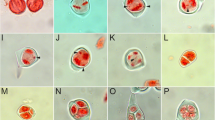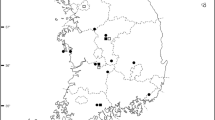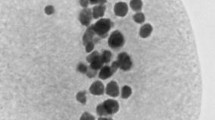Summary
Colchicine induced tetraploid (2n=4x=36) Brachiaria ruziziensis were used as female parent in crosses with apomictic tetraploid species (2n=4x=36) Brachiaria decumbens and Brachiaria brizantha. Tetraploid B. ruziziensis pollinated with B. decumbens set significantly more seed than selfed or crossed with B. brizantha. The crossability between B. ruziziensis and B. decumbens is also better than between B. ruziziensis and B. brizantha. In addition, hybrid seedlings obtained in crosses involving B. brizantha are more frequently lethal. All the viable F1 hybrids are tetraploid with 36 chromosomes. Meiotic chromosome behaviour suggest that the three species belong to the same genomic group and therefore the same agamic complex. Chromosome associations at metaphase I do not allow to identify fertile and sterile hybrids. The interspecific hybrids averaged a lower fertility than their female parent, but some hybrids were more fertile than their apomictic male parent.
Similar content being viewed by others
References
Asker, S., 1979. Progress in apomixis research. Hereditas 91: 231–240.
Bashaw, E.C., 1980. Apomixis ans its application in crop improvement. In: W. Fehr (Ed.) & H. Hadley, Hybridization in Crop Plants. Madison, Wisconsin, USA.
Bogdan, A.V., 1959. The selection of tropical ley grasses in Kenya: general considerations and methods. E. Afr. Agric. J. 24: 206–217.
Bothmer, R., von, M., Bengtsson, J., Flink & I., Linde-Laursen, 1988. Complex interspecific hybridization in barley (Hordeum vulgare L.) and the possible occurrence of apomixis. Theor. Appl. Genet. 76: 681–690.
Bronckers, F., 1963. Variations polliniques dans une série d'autopoplyploïdes artificiels d'Arabidopsis thaliana (L) Heynh. Pollen et spores 5(2): 233–238.
Brown, W.F. & W.H., Emery, 1958. Apomixis in the Gramineae: panicoideae. Amer. J. Bot. 45: 253–263.
Burton, G.W. & I. Forbes, 1960. The genetic and manipulation of obligate apomixis in common Bahia grass (Paspalum notatum Flugge). Proc. 8th Int. Grassl. Cong.: 66–71.
Dujardin, M. & W.W., Hanna, 1985. Cytology and reproduction of reciprocal backcrosses between pearl millet and sexual and apomictic hybrids of pearl millet x Pennisetum squamulatum. Crop Sci. 25: 59–62.
Dujardin, M. & W.W., Hanna, 1988. Production of 27-, 28-, and 56-chromosome apomictic hybrid derivaties between pearl millet (2n=14) and Pennisetum squamulatum (2n=54). Euphytica 38: 229–235.
Ferguson, J.E., 1974. Method of reproduction in Brachiaria ruziziensis Germain et Evrard. Cornell Univ. Phd. thesis, pp. 149.
Germain, R. & C., Evrard, 1953. Un nouveau Brachiaria de l'est du Congo belge. Jard. Bot. de l'État, 23(3–4): 373–377.
Gill, B.S., Minocha, J.L., D., Gupta & D., Kumar, 1969. Chromosome behaviour and seed setting in autotetraploid pearl millet. Indian J. Genet. 29(3): 462–467.
Hanna, W.W. & M. Dujardin, 1986. Interspecific transfer of apomixis in Pennisetum. Proc. XV Int. Grassl. Cong. Tokyo, Japan: 249–250.
Harding, W.A.T., 1972. The contribution of plant introduction to pasture development in the wet tropics of Queensland. Tropical Grassl. 6: 191–199.
Harlan, J.R., M.H., Brooks, C., Borgaonkar & J.M., Dewet, 1964. Nature and inheritance of apomoxis in the Botriochloa and Dichanthium. Bot. Gaz. 125: 41–46.
Hunkar, A.E.S., 1965. Three Brachiaria sp. adapted to well drained soils. Bull. Landbouwproefstation Suriname 82: 193–196.
Jones, R.J. & A.J., Pritchard, 1971. A method of reproduction in Rhodes grass (Chloris gayana Kunth). Trop. Agric. 48: 301–307.
Kellogg, E.A., 1987. Apomixis in the Poa secunda complex. Amer. J. Bot. 74(9): 1431–1437.
Komatsu, T. & S., Suzuki, 1987. Chromosome numbers, chromosome behaviour and mode of reproduction in introduced strains of Panicum species. Journal of Japanese Society of Grassland Science 33(1): 56–61.
McMullen, M.S., R.L., Phillips & D.D., Stuthman, 1982. Meiotic irregularities in Avena sativa L. x A. sterilis L. hybriss and breeding implications. Crop Sci., 22: 890–897.
Morrison, J.W. & T., Rajhathy, 1960. Frequency of quadrivalents in autotetraploids plants. Nature 167: 528–530.
Ngendahayo, M., 1988. Mecanismes de la reproduction dans le genre Brachiaria Gris. et stratégies d'amélioration et de sélection. Université Catholique de Louvain, Phd. thesis, pp. 165.
Pickering, R.A. & P.W., Morgan, 1985. The influence of temperature on chromosome elimination during embryo development in crosses involving Hordeum spp., wheat (Triticum aestivum L.) and rye (Secale cereale L.). Theor. Appl. Genet. 70: 189–206.
Pritchard, A.J., 1967. Apomixis in Brachiaria decumbens Stapf. J. Austr. Inst. Agric. Sci. 33: 264–265.
Quarin, C.L. & W.W., Hanna, 1980. Effect of three ploidy levels on meiosis and mode of reproduction in Paspalum hexastachyum. Crop Sci. 20: 69–75.
Reid, R.L., A.G., Post, F.J., Olsen & J.S., Mugerwa, 1973. Studies on the nutritional quality of grasses and legumes in Uganda. I. Application of in vitro digestibility techniques to species and stage of growth effects. Trop. Agric. 50: 1–15.
Savidan, Y., 1982. Nature et hérédité de l'apomixie chez Panicum maximum Jacq. Travaux et Documents de l'ORSTOM. 153: 1–159.
Schank, S.C. & A., Sotomayor-Rios, 1968. Cytological studies on Brachiaria species. Soil Crop. Sci. Soc. Florida Proc. 28: 156–162.
Sotomayor-Rios, A., J., Velez-Fortuno, R., Woodbury, K.F., Schertz & A., Sierra-Bracero, 1960. Description and cytology of a form of signal grass (Brachiaria brizantha Stapf) and its agronomic behaviour compared to Guinea grass (Panicum maximum Jacq). J. Agr. Univ. Puerto-Rico 44: 208–220.
Subrahmanyam, N.C. & R., von, Bothmer, 1987. Interspecific hybridization with Hordeum bulbosum and development of hybrids and haploid. Hereditas 106: 119–127.
Swenne, A., B.P., Louant & M., Dujardin, 1981. Induction à la colchicine de formes autotetraploïdes chez Brachiaria ruziziensis Germain et Evrad (Graminée). Agron. Trop. 36(2): 134–141.
Taliafero, C.M. & E.C., Bashaw, 1966. Inheritance and control of obligate apomixis in breeding buffalograss (Pennisetum ciliare). Crop Sci. 6: 473–476.
Valle, C.B. Do., 1987. Cytology, mode of reproduction and forage quality of selected species of Brachiaria Gris. Dissertion Abstracts International, B(Sciences and Engineering) 47(7): 2679.
Valle, C.B. Do., K.J., Moore & D.A., Miller, 1988. Cell wall composition and digestibility in five species of Brachiaria. Trop Agric 65(4): 337–340.
Voight, P.W. & E.C., Bashaw, 1972. Apomixis and sexuality in Eragrostis curvula. Crop Sci. 12: 843–847.
Weber, J.E. & C.S., Campbell, 1989. Breeding system of a hybrid between a sexual and an apomictic species of Amelanchier Shadbush (Rosaceae, Maloideae). Amer. J. Bot. 76(3): 341–347.
Author information
Authors and Affiliations
Rights and permissions
About this article
Cite this article
Lutts, S., Ndikumana, J. & Louant, B.P. Fertility of Brachiaria ruziziensis in interspecific crosses with Brachiaria decumbens and Brachiaria brizantha: meiotic behaviour, pollen viability and seed set. Euphytica 57, 267–274 (1991). https://doi.org/10.1007/BF00039673
Received:
Accepted:
Issue Date:
DOI: https://doi.org/10.1007/BF00039673




